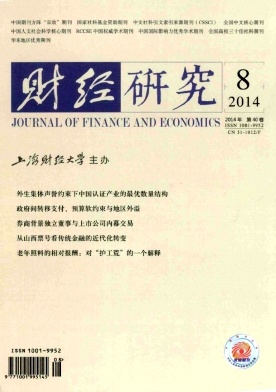政府间转移支付、预算软约束与地区外溢
财经研究 2014 年 第 40 卷第 08 期, 页码:57 - 66
摘要
参考文献
摘要
文章根据中国2002—2012年31个省区的面板数据,运用一步系统广义矩(sysGMM)回归方法,建立转移支付预期实证模型,对转移支付是否诱发地方政府的预算软约束行为及其外溢范围以及其与税收竞争和财政竞争的综合影响进行了系统的实证研究。研究发现:转移支付预算软约束问题并非发生于个别省份,争夺转移支付的连锁反应促使各地区共同参与从而形成策略互补性质的竞争。其不仅对地方政府自主筹资产生了负面激励,同时在控制了自有财力下降的潜在影响和转移支付的"粘蝇纸效应"后,仍能够发现预算软约束对财政支出的扩张效应。这种支出扩张中体现了转移支付预算软约束与财政竞争之间的替代效应和收入效应的共同影响。
[1]范子英,张军.财政分权、转移支付与国内市场整合[J].经济研究,2010,(3):53-64.
[2]郭庆旺,贾俊雪,高力.中央财政转移支付与地区经济增长[J].世界经济,2009,(12):15-26.
[3]卢洪友,龚锋.政府竞争、“攀比效应”与预算支出受益外溢[J].管理世界,2007,(8):12-22.
[4]Akai N,Silva E C D.Interregional redistribution as a cure to the soft budget syndrome in federations[J].International Tax and Public Finance,2009,16(1):43-58.
[5]Akai N,Sato M.Too big or too small?A synthetic view of the commitment problem of interregional transfers[J].Journal of Urban Economics,2008,64(3):551-559.
[6]Caplan A J,Silva E C D.Impure public goods,matching grant rates and income redistribution in a federation with decentralized leadership and imperfect labor mobility[J].International Tax and Public Finance,2011,18(3):322-336.
[7]Caplan A J,Cornes R C,Silva E C D.Pure public goods and income redistribution in a federation with decentralized leadership and imperfect labor mobility[J].Journal of Public Economics,2000,77(2):265-284.
[8]Crivelli E,Staal K.Size,spillovers and soft budget constraints[J].International Tax and Public Finance,2013,20(2):338-356.
[9]Dewatripont M,Maskin E.Credit and efficiency in centralized and decentralized economies[J].The Review of Economic Studies.1995,62(4):541-555.
[10]Hindriks J,Peralta S,Weber S.Competing in taxes and investment under fiscal equalization[J].Journal of Public Economics,2008,92(12):2392-2402.
[11]Koethenbuerger M.Federal tax-transfer policy and intergovernmental pre-commitment[J].Regional Science and Urban Economics,2008,38(1):16-31.
[12]Koethenbuerger M.How do local governments decide on public policy in fiscal federalism?Tax vs.expenditure optimization[J].Journal of Public Economics,2011,95(11-12):1516-1522.
[13]Rodden J A,Eskeland G S.Fiscal decentralization and the challenge of hard budget constraints[M].Cambridge:MIT Press,2003.
[14]Sorribas-Navarro P.Bailouts in a fiscal federal system:Evidence from Spain[J].European Journal of Political Economy,2011,27(1):154-170.
1地方政府财力改善可能会刺激地方的财政支出规模过度扩张,表现为地方财政支出对转移支付的弹性较大,即转移支付会带来地方财政支出的“粘蝇纸效应”(Flypaper Effect)。同时,在财政支出结构方面,现有研究多数认为地方财力状况改善还有可能导致财政支出发生扭曲,使政府支出偏向于行政性支出、基本建设支出。
1 数据来源于《中国财政年鉴2003》和《中国财政年鉴2012》。
2 分权化领导理论与传统的预算软约束理论在某些理论建构方面不完全一致,传统的预算软约束模型(如Dewatripoint和Maksin,1995)基于局部均衡的契约环境,考虑委托人和代理人之间的纵向财政联系;而分权化领导模型致力于解释一般均衡效应,即辖区之间事先的横向和纵向交互影响引发的外部性。预算软约束模型考虑救助是一个随机和抽象的事件,地方政府执行的公共项目时刻处于风险之中,而在分权化领导模型中,不存在不确定性,救助具体体现在事后性质的转移支付之中,并且自然而然地对地方政府的行为做出反应。可参见Akai和Sato(2008)的详细比较。
1 以2011年人均GDP水平为标准,划分了三个区间,其中第一档次为发达地区,包括北京、天津、内蒙古、辽宁、上海、江苏、浙江、福建、山东和广东;第二次为中等发达地区,包括河北、山西、吉林、黑龙江、湖北、重庆、山西、宁夏和新疆。剩余12 个省区为第三档次。
[2]郭庆旺,贾俊雪,高力.中央财政转移支付与地区经济增长[J].世界经济,2009,(12):15-26.
[3]卢洪友,龚锋.政府竞争、“攀比效应”与预算支出受益外溢[J].管理世界,2007,(8):12-22.
[4]Akai N,Silva E C D.Interregional redistribution as a cure to the soft budget syndrome in federations[J].International Tax and Public Finance,2009,16(1):43-58.
[5]Akai N,Sato M.Too big or too small?A synthetic view of the commitment problem of interregional transfers[J].Journal of Urban Economics,2008,64(3):551-559.
[6]Caplan A J,Silva E C D.Impure public goods,matching grant rates and income redistribution in a federation with decentralized leadership and imperfect labor mobility[J].International Tax and Public Finance,2011,18(3):322-336.
[7]Caplan A J,Cornes R C,Silva E C D.Pure public goods and income redistribution in a federation with decentralized leadership and imperfect labor mobility[J].Journal of Public Economics,2000,77(2):265-284.
[8]Crivelli E,Staal K.Size,spillovers and soft budget constraints[J].International Tax and Public Finance,2013,20(2):338-356.
[9]Dewatripont M,Maskin E.Credit and efficiency in centralized and decentralized economies[J].The Review of Economic Studies.1995,62(4):541-555.
[10]Hindriks J,Peralta S,Weber S.Competing in taxes and investment under fiscal equalization[J].Journal of Public Economics,2008,92(12):2392-2402.
[11]Koethenbuerger M.Federal tax-transfer policy and intergovernmental pre-commitment[J].Regional Science and Urban Economics,2008,38(1):16-31.
[12]Koethenbuerger M.How do local governments decide on public policy in fiscal federalism?Tax vs.expenditure optimization[J].Journal of Public Economics,2011,95(11-12):1516-1522.
[13]Rodden J A,Eskeland G S.Fiscal decentralization and the challenge of hard budget constraints[M].Cambridge:MIT Press,2003.
[14]Sorribas-Navarro P.Bailouts in a fiscal federal system:Evidence from Spain[J].European Journal of Political Economy,2011,27(1):154-170.
1地方政府财力改善可能会刺激地方的财政支出规模过度扩张,表现为地方财政支出对转移支付的弹性较大,即转移支付会带来地方财政支出的“粘蝇纸效应”(Flypaper Effect)。同时,在财政支出结构方面,现有研究多数认为地方财力状况改善还有可能导致财政支出发生扭曲,使政府支出偏向于行政性支出、基本建设支出。
1 数据来源于《中国财政年鉴2003》和《中国财政年鉴2012》。
2 分权化领导理论与传统的预算软约束理论在某些理论建构方面不完全一致,传统的预算软约束模型(如Dewatripoint和Maksin,1995)基于局部均衡的契约环境,考虑委托人和代理人之间的纵向财政联系;而分权化领导模型致力于解释一般均衡效应,即辖区之间事先的横向和纵向交互影响引发的外部性。预算软约束模型考虑救助是一个随机和抽象的事件,地方政府执行的公共项目时刻处于风险之中,而在分权化领导模型中,不存在不确定性,救助具体体现在事后性质的转移支付之中,并且自然而然地对地方政府的行为做出反应。可参见Akai和Sato(2008)的详细比较。
1 以2011年人均GDP水平为标准,划分了三个区间,其中第一档次为发达地区,包括北京、天津、内蒙古、辽宁、上海、江苏、浙江、福建、山东和广东;第二次为中等发达地区,包括河北、山西、吉林、黑龙江、湖北、重庆、山西、宁夏和新疆。剩余12 个省区为第三档次。
引用本文
汪冲. 政府间转移支付、预算软约束与地区外溢[J]. 财经研究, 2014, 40(8): 57–66.
导出参考文献,格式为:





 7060
7060  4379
4379

